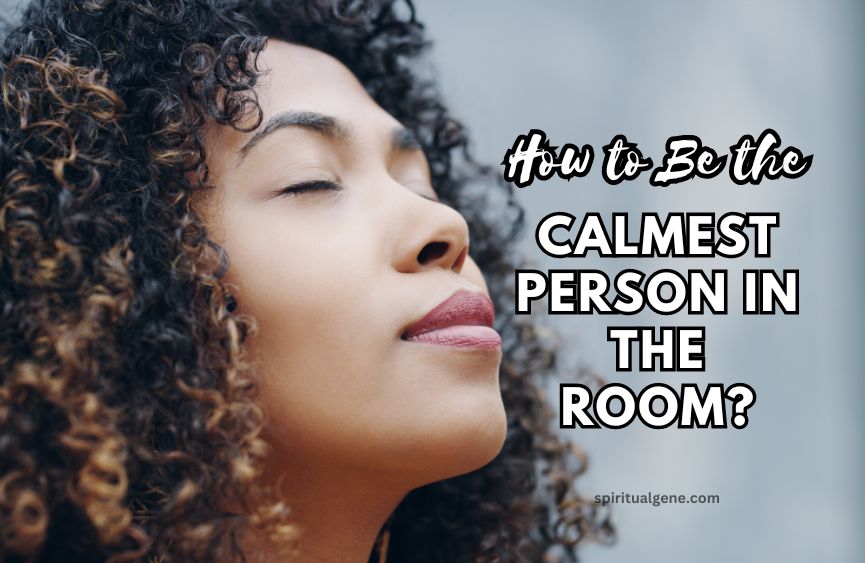How to Be the Calmest Person in the Room?
When facing life’s ups and downs, remaining calm is a valuable skill. Being the calmest person in the room can make a difference, whether dealing with a stressful meeting at work, a challenging family gathering, or a nerve-wracking presentation. In this article, we will explore the art of maintaining your composure, even in the stormiest of situations.
What is Calmness, Anyway?
Before we dive into the how-tos, let’s first get a grasp on what calmness means. Calmness is that serene state of being where you feel relaxed as a cucumber, unperturbed by external chaos, and in control of your emotions. It’s like having an invisible shield that protects you from stress and anxiety. Being calm is not about suppressing your feelings; it’s about managing them effectively and not letting them run the show.
Why Should You Strive for Calmness?
Calmness is not just a fantastic personality trait; it’s a life skill that can work wonders in various situations. Imagine being the one who keeps a level head during a crisis – you become the anchor for others, the voice of reason, and the source of inspiration. Calmness can improve your decision-making, enhance your relationships, and even boost your overall well-being.
Achieving Calmness: It’s Not Rocket Science
So, how can you be the calmest person in the room? Let’s break it down.
1. Master Your Breath (Breathing Exercises):
When life’s tempests brew, your breath becomes your anchor. It’s the ability to pause and take a deep, cleansing breath, allowing it to wash over you like a soothing wave. Inhale slowly, filling your lungs with fresh air, and exhale, releasing pent-up tension. It’s a simple practice, yet it possesses a remarkable power to reset your emotional barometer and steer you toward serenity in the face of turmoil.
2. Get Mindful (Mindfulness Meditation):
Think of mindfulness meditation as your mental gym. It’s the practice of staying rooted in the present, letting go of the cacophony within your mind, and fully immersing yourself in the “now.” Spending a few minutes each day in mindful contemplation can transform the chaos of your thoughts into a tranquil oasis, a sanctuary of peace within.
3. Visualize Serenity (Visualization Techniques):
Close your eyes and let your imagination whisk you away to your personal haven of tranquility. Envision the gentle lapping of waves on a serene beach, the rustling leaves in a secluded forest, or the snug embrace of your favorite cozy nook. Visualization is your boarding pass to a calm realm, where you can find solace and equilibrium, even amidst life’s storms.
4. Positive Self-Talk:
The way you converse with yourself matters. Instead of being your own critic, be your cheerleader. Replace self-doubt and negativity with positive affirmations. Tell yourself that you’re not just capable, but you’re in control and can handle any storm life throws your way. Positivity becomes your trusty companion on the road to calmness, your shield against the chaos that seeks to disrupt your equilibrium.
5. Get Moving (Physical Exercise):
Exercise isn’t just about keeping your physical form in check; it’s a natural stress-buster. Even a short stroll can work wonders in clearing your mind, releasing endorphins, and banishing stress to the shadows. Whether it’s the grace of yoga, the rhythm of jogging, or the joy of dancing in your living room, moving your body unlocks the door to inner tranquility.
6. Time Management:
Procrastination and the rush of last-minute tasks are stress’s closest allies. Organizing your day, creating to-do lists, and efficiently allocating time minimize unnecessary stress. Time management isn’t just about getting things done; it’s about maintaining your peace, allowing you to be the calm eye amid life’s storms.
7. Watch Your Intake (Caffeine and Sugar):
That morning cup of coffee and sugary snack may provide a quick energy boost. Still, they can also fuel jitteriness and anxiety. By moderating your caffeine and sugar intake, you preserve your inner tranquility and minimize the chances of getting swept away in emotional turbulence.
The Power of Body Language
Your body language is like a billboard displaying your emotions. Slouched shoulders and fidgety movements can convey anxiety and nervousness. Keep a relaxed posture, maintain eye contact, and use open gestures to appear calm, collected, and confident.
Communication: The Calmness Connector
Your words and tone can either calm a storm or add fuel to the fire. Practice active listening, choose your words carefully, and speak in a composed, even manner. This can de-escalate tense situations and make you the go-to person in a crisis.
Conclusion
In a world that often feels like a whirlwind, being the calmest person in the room is a superpower. It’s the ability to influence situations and guide them towards a peaceful resolution. Remember that achieving calmness is not a one-time thing; it’s a practice that grows with you. So, take a deep breath, visualize serenity, and step into a world where your calm demeanor is your most potent weapon.
Calmness isn’t just about being unflappable in the storm; it’s about being the beacon of serenity that others gravitate towards. Start your journey to becoming the calmest person in the room today, and watch how it transforms your life.
How to Be the Calmest Person in the Room – FAQ
What Does It Mean to Be the Calmest Person in the Room?
To be the calmest person in the room means possessing the extraordinary ability to maintain a serene and composed demeanor, even in the face of chaos and stress. It’s not about suppressing emotions but effectively managing them, like a captain steering a ship through turbulent waters. Such an individual exudes a sense of poise and tranquility that can be a soothing influence on those around them.
How Does a Calm Person Behave?
A calm person behaves with a sense of grace under pressure. They maintain a steady demeanor, keeping emotions in check while fully present. Their words are measured, and their tone is even, helping de-escalate tense situations. They often exhibit positive self-talk, emphasizing their ability to handle challenges. A calm individual uses body language that reflects confidence and composure, such as maintaining eye contact, relaxed posture, and open gestures.
Why Is Calmness Attractive?
Calmness is attractive for several reasons. It signifies emotional intelligence, the ability to handle stress, and resilience. Calm individuals are often seen as reliable and trustworthy because they make well-considered decisions, are effective problem solvers, and are a source of comfort in difficult times. This attractiveness stems from the perception of maturity, self-assuredness, and the ability to navigate life’s challenges gracefully.
Is It Good to Be a Calm Person?
Yes, it is highly beneficial to be a calm person. Calmness is a valuable life skill that can enhance personal and professional relationships, decision-making, and overall well-being. It allows individuals to respond to adversity with clarity and poise, making them more effective in various situations. Calmness is a crucial attribute for success in both personal and professional realms, offering emotional stability and resilience.
Do Girls Like Calmness?
Calmness is generally an attractive quality for both genders. It conveys emotional maturity, the ability to handle stress, and a sense of reliability, which can appeal to anyone. However, individual preferences vary, and what one person finds attractive may differ from another. Some individuals may appreciate a calm and composed partner, while others may value other personality traits. It’s important to remember that there is no one-size-fits-all answer to what people find attractive in a partner, as it depends on individual preferences and compatibility.







